Another year, and another visit to CES in the bag. Here are my notes.
As with previous years’, these notes are not intended to be comprehensive, they just happen to be things that caught my eye as I raced through the exhibits.
| |The show was even bigger this year. An estimated 2.6 million square feet of exhibition space over multiple halls, and 3,800 exhibiters. Attendance was projected to be over 180,000 people I visited for two days this year and did my best to see as many booths as possible. In no particular order here are my thoughts:|
|The show was even bigger this year. An estimated 2.6 million square feet of exhibition space over multiple halls, and 3,800 exhibiters. Attendance was projected to be over 180,000 people I visited for two days this year and did my best to see as many booths as possible. In no particular order here are my thoughts:|
TVs
|It would not be CES without a fresh batch of TVs. As I commented in previous years, TVs are not getting any bigger; there’s just no need. People’s living rooms are fixed in size and when you place a screen on your wall, there’s only so far you can get back from it before you hit the rear wall. If you have too large a TV, the angle the picture subtends to your eye gets too great for enjoyment.Manufacturers have combated this potential stagnation by tweaking and improving other things to make upgrading desirable; they’ve made them thinner, they’ve made them curved, they’ve made them higher resolution, and they’ve made massive improvements in picture quality and contrast.In the past, they’ve also attempted other changes that have since died away; nobody was showing any 3D screens, and nobody was evangelizing about the smartness of their TVs. These days TVs might have streaming services built in, but nobody talks about installing applets on their TVs. TV’s have become more and more like (dumb) computer monitors; displaying pixels that are generated, decoded and sourced from external devices. Many of the TVs didn’t have internal speakers, instead leveraging sound bars and external speakers.|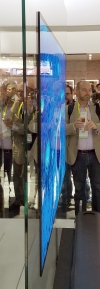 |
|
Manufacturers have combated this potential stagnation by tweaking and improving other things to make upgrading desirable; they’ve made them thinner, they’ve made them curved, they’ve made them higher resolution, and they’ve made massive improvements in picture quality and contrast.
The TVs on display were utterly stunning: The colours were vibrant, the blacks were impossibly black, the shades impressively vivid, the contrast staggering, and the refresh rates superb. Each display was dialed-in perfectly, looping through award winning content demonstrations. The bevels were miniscule; the pictures flowing to the edge, and many of the screens seemed impossibly thin (it’s hard to describe how weird it is to see a 77” TV that is thinner than your phone). If you buy any of the TVs that were on display, irrespective of the manufacturer, you’ll be very happy.
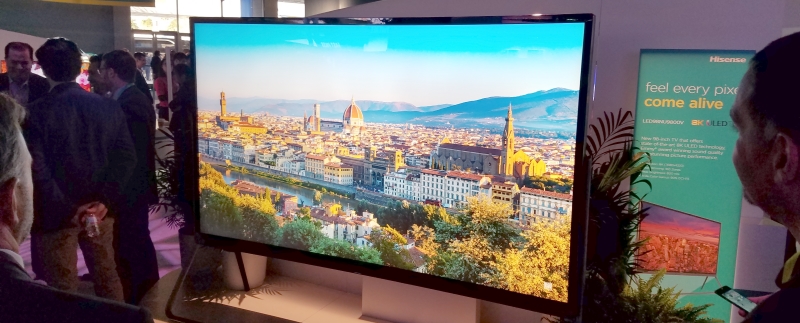
 |
As ever there were buzz words. OLED technology still seems to be the premium technology of choice, and there are now a confusing set of HDR, Ultra HDR (high dynamic range) monikers and claims. This year various companies were espousing the benefits of “Quantum Dot Technology” (or as another competing company called them “Nano Dots”). |
LG was showing a tunnel of TVs on their booth that was “Two Gross” (get it?); they tiled 288 TV’s together.

There were large TVs on display. The largest I saw was a 98” 8k device. I seem to remember seeing this exact same display, in the exact location, not just last year, but also the year before as well, when all the competitors were trying to boast who had the largest flat panel display at the show. (It seems Hawaii didn’t get the memo that manufacturers are not try to boast who has the largest TV anymore).
|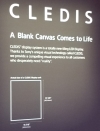 |Sony were showing a very impressive video wall. This was comprised of hundreds of tessellated CLED bricks (Crystal LEDs). The interfaces between the blocks were seamless; there were no cracks or lines visible overthe entire display. The colours were uniform across all the blocks, and the brightness was spectacular. It was one of the highlights of the show for me.|
|Sony were showing a very impressive video wall. This was comprised of hundreds of tessellated CLED bricks (Crystal LEDs). The interfaces between the blocks were seamless; there were no cracks or lines visible overthe entire display. The colours were uniform across all the blocks, and the brightness was spectacular. It was one of the highlights of the show for me.|
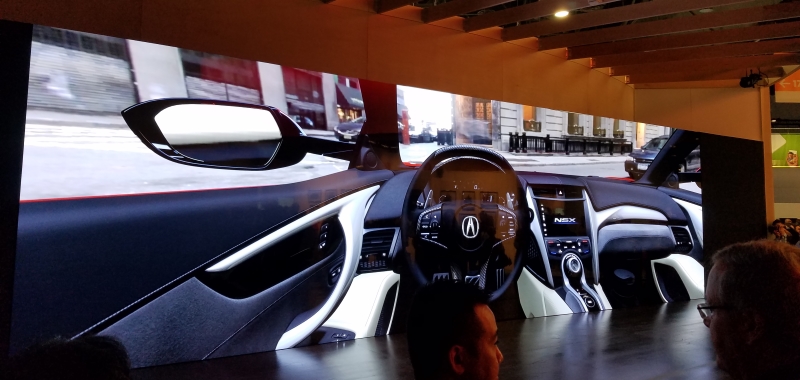
Smart, Connected, and IoT
Everyone was talking about the “Internet of Things”. IMHO a good majority of these things were pointless. Just because you can connect a spatula to the internet, it does not mean that you should.
The adjective “Smart” seemed to prefix every other piece of technology on display this year: Smart Fridges, Smart pans, Smart Toasters, Smart Coffee Pots, Smart Cribs, mirrors, bras, girdles, shoes, houses, bags, toilets, plugs, pillows, beds, cuddly toys, blankets, umbrellas, toothbushes, wine sensors, shoe inserts, hair brushes, trash cans, door locks, lights, airbags, pool monitors, bathtoys …
Those devices that were not described as “Smart” were described as “Connected”. I think there is a subtle difference in terminology. A connected device, by definition, has interface to the cloud and must therefore be smart, but a smart device does not necessarily need an IP address, it can just have clever electronics. I think, for many devices, smart (microprocessor controlled) is probably good enough.

Currently, it’s all going a little too far. Do we really need a toaster that we can turn on remotely from a web page? Sure, it a nice gimmick the first couple of times you use it, but here’s a dirty secret: You have to walk over to the toaster to collect your toast when its ready! If you have to physically be there for the payout, you might as well drop the bread in when you want it. It’s not as if toasting is a long process, and it’s not even saving you time as if you do want to use it on demand, you’d have had to pre-load at some time earlier (“Hmmm, at some time in my future I might possibly want a piece of toast so I’ll take the time now to load the bread to save me the same effort some time in the future!”) And what happens if you change your mind between loading and consuming? What if you now want a toasted bagel, but the machine is pre-loaded with wheat bread? Remote toasters are just as pointless as remote DVD eject buttons; if you physically have to get up and walk across the room to put a new disk in, what has opening and closing the drawer from your armchair saved you? It’s the same with kettles and coffee pots (one of which won an award at CES!). Does a coffee pot really need an IP address? Sure it would be nice to wake up to a fresh cup of coffee or tea, but does it really need a multi-megahertz processor to do this? 40 years ago, analog tea/coffee-mate bedside alarm clocks did just the same admirable job with a lot less sophistication.
I’m sure that, inevitably, just about every electrical device will eventually become smart, addressable, and logable, despite the lack of need. This will just naturally happen once the boards to handle this interface become so cheap, and standards are locked in stone, but we’re at least a decade away from this. Your average kitchen appliance has a lifespan of at least ten years. If you drop $10k on a Fridge (and the smart fridges are considerably more than this), you’re going to want to amortize this over a decade, not to have it obsolesce after a year. Just take a look at your cellphone or laptop to see how rapidly technology changes. Would you hand back your latest Android Phone or iPhone and go back to a flip phone, brick, or Mars bar phone that you were using 10 years ago? (How many phones have you purchased in the last 10 years?)
And what about security patches? The major players: Microsoft, Google, Apple … release multiple patches a year to plug security vulnerabilities discovered in their code. These companies are great at what they do, and employ some of the smartest engineers in the world. If they have difficulty keeping pace with security issues, how much do you trust the security expertise of a random non-tech kitchen appliance manufacturer, and trust them to keep up with the latest exploits? Even if they can keep pace, do you want to have to regularly patch devices to use them? “It’s a nice evening, let’s BBQ. Hold on, I have to rollback and then reapply the latest patches once I’ve flashed the firmware on the grill” or have to dedicate time “Sorry, I can’t go out to dinner tonight, I’m spending the evening updating all the house appliances, and it doesn’t always go well”.
Some companies will go under and their devices will go unsupported and unpatched. Even Microsoft does not support versions of its browser and OS past a couple of years; who is going to expect an OEM white good manufacturer to keep supporting patches years after they stop making the product? If the only choice to keep secure is to disconnect from the web, what was the point of having it? (or, will you risk tip-toeing down to your unpatched smart fridge, the one with the camera on it, in the middle of the night, naked, when you go down for a midnight snack? Or risk that, at any time, a hacker can adjust the temperature of your fridge, or determine its contents )
Finally, I’ve seen many smart devices that suddenly go very dumb if they can’t connect to the cloud. I don’t know about your ISP, but mine is not 100% reliable. It would be a shame not to be able to make toast, or make coffee, even if you have power, because your internet connection is down.
I’d like a smart toaster. I’d like it to have sensors that detect the type of bread; its thickness and moisture content. I’d be happy if it had sophisticated toasting profiles and could pulse-width modulate the current of the heating elements to make perfectly toasted products to my specified liking. What I’d really like (and I’ve yet to see a toaster that has this), is a toaster with a highly visible simple progress bar showing the evolution of the toasting process and an indication of how much time is yet to run. That’s it. I don’t need it to text me when it’s finished, I don’t need it to start a conversation with the oven, and I don’t need to be able to graph and trend my consumption of bread products over the last month.
Fridges
It seems, however, that people have not been listening to me. They are still making smart fridges. The ambitious ones now have two screens, one of each door. It’s not that I don’t like technology, it’s just that I think you will be very disappointed with the dinosaur you’ve purchased in a few years time.
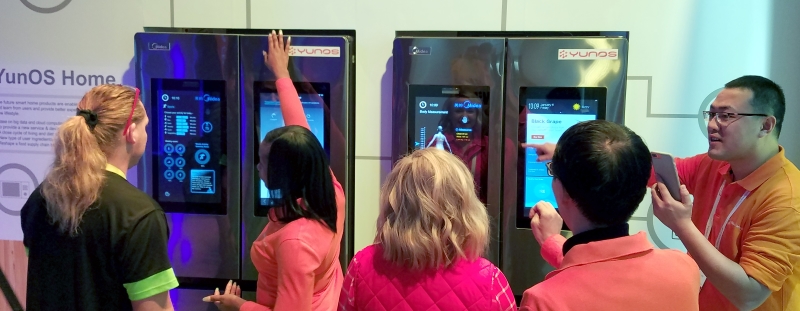
If you do want a tech fridge, I did, however, see a clever idea and possible justification for an LCD panel on a fridge. LG were showing a fridge with an opaque front that, if you tapped it with your knuckles, turned temporarily clear so you could see what was in the fridge. It allowed you to look inside “without losing your cool”. This saves energy as you can see if there are eggs inside the fridge without opening it (and masks the otherwise random mess of fridge contents that would be on display if it was always transparent).
Another use of semi-transparent glass displays was a mock-up of a hospitality booth in a football stadium with a glass window onto which was projected meta information about the game. It looked pretty good.

It’s not just the TVs that are curved. Desktop monitors are getting so broad these days that the gentle curves help keep down the reflection and (not sure if this is a thing), reduces eye strain as all points of the display at the same focal distance from your eye. It also looks cool if you tile them together to make an awesome gaming rig.
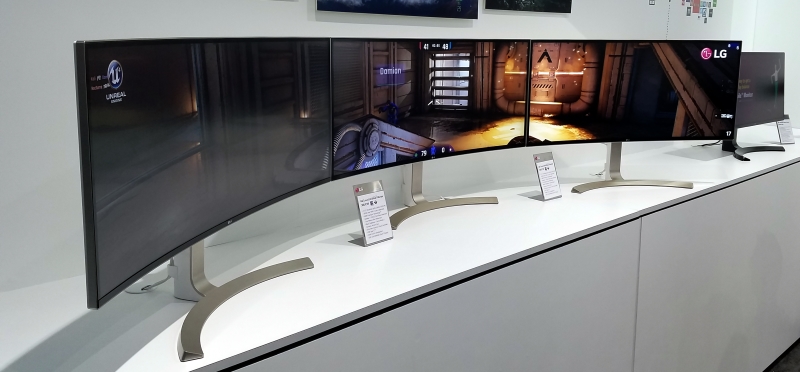
Outdoors
Casio were showing a watch that doesn’t just have a GPS in it, but also has built in maps and a nice display so that you can use it as a personal navigation device when hiking outdoors. This is a neat gadget. Clearly these are late model prototypes and there were strong warning messages to please discharge your static charge before touching rather than risk frying them. I bet, however, that this device drinks batteries. It tried to push hard how long the battery would last with GPS on, and all I could squeeze out of the staff was “It depends how it’s used”. So give me a range then, with GPS on, or off, or estimated usage? They refused to comment at all. I’m not picking on Casio; all smart wearable devices (especially when GPS is on) drink power. This might be acceptable in a work/home environment where you can constantly top it up from charge stations on your desk or by your bed, but the very nature of this device is to be used when enjoying the outdoors (hiking, skiing, backpacking …). These are activities enjoyed in locations where there are not recharging outlets on every corner. And yes, whilst you can carry a remote top-up battery to give it a boost every hour or so, this is sacrificing a lot of the functionality (why not make the watch a simple lower power remote screen, and have the GPS device along with a fatter battery inside your backpack?)
This does segue nicely into another category of devices. All sizes and shapes of external battery packs were on display, along with a great mix of solar chargers. Some could be draped over a backpack to allow charging of devices as you walked, others folded out from a notebook like sheets of flat paper, and others entire camp-site opening sheets of cells to charge a large battery for the camp.
Some battery packs were built into water bottles, and some of these water bottles also housed Bluetooth connected speakers. External battery packs seemed to be a pretty big category on display highlighting our dependence and love of our remote electronic devices and that battery technologies have not quite kept pace. Either battery technology needs to improve charge density significantly, or support rapid charging (a few seconds needed to top-up from empty to full), to make use of our power hungry toys more convenient.
External battery packs are not just functional; They are being turned into fashion accessories with style. Differnet colours and finishes, leather, crystals and branding. It’s the next waze of customisation after smart phone covers. Some are even incorporating the batteries into other items. I saw top-up chargers inside purses, copacts and brief cases.
Cameras
The proliferation of smartphones, all with embedded multi-pixel cameras, has essential killed off the point-and-shoot and compact camera category. However, there is still a professional market for high-end digital SLR cameras. The major players were showing their products and their impressive (and expensive) range of lenses. These cameras are not just used for stills; for many they are the devices used to record films and movies.

 |
A sign of the times is an increase in the size of the wearable body cam market. Hopefully this is a niche market, and smaller than the dash-cam recorders that seem a pretty mature market in many countries. |
Drones’R’Us
Every size of shape of drone was on display. All the way from single rotors to massive multi-rotor vehicles large enough to carry a person. Some could be folded up into compact shapes that would fit into a backpack. Some could carry fluids for remote crop spraying. All had cameras of varying resolutions, and I even saw one with a FLIR camera for capturing thermal images. The blue one one in the middle right below captures spherical video.
This is how it all starts: One company attached a five shot BB gun to one of their drones and was offering prizes to people who could knock down targets.
Not much further away was a drone shooting gun that fired tennis balls using compressed a compressed air cylinder. Not marketed directly as an anti-drone weapon, they were demoing this more like an automated skeet shooting game using very damage tolerant drones as flying targets.
Oh, and there were also submarines.
Automotive Industry
Last year, I made the prediction that the automotive industry was going to change more in the next half dozen years than it had in the last half century. I’m sticking with this prediction, and it’s already started, so I’ll update my prediction. The automotive industry is going to change more in the next five years than it has over the last fifty-one years.
The next generation of self-driving, autonomous and assisted cars have more processing power than a wheel-barrow full of Xboxes. Recent announcements by nVidia show they are aiming squarely for this opportunity. Here’s a shot of the trunk of a research vehicle. Can you spot me in the live Lidar image below?
| |The automotive industry is going to change more in the next five years than it has over the last fifty-one years.|
|The automotive industry is going to change more in the next five years than it has over the last fifty-one years.|
You know what I can tell you about cars of the future? They will not have ‘B’-pillars! All the concept vehicles on display had doors that swung and pivoted in opposite directions. With both sets of doors open, the interior space is more easily accessible and gave the inside a more cabin-like feel. With self driving technology, the drivers chair could rotate around 180° to allow conversation and interaction with the rest of the passengers in the pod.

|

Polarizing Technology
If the devices on display at CES are anything to go by, future society is going to become polarized and stratified: The healthy, active, people will be leveraging technology to help them become more and more efficient; gamifying their activities. The less active people will be leveraging technology to become more sedentary; their products will be ordered and delivered without having to get up from their chairs that will move them around on wheels.

At one end of the scale are the people who use devices like fit-bits: They monitor their workouts, their sleep, their food, their weight … Everything to them is gamified, recorded, and pushed into the cloud. At the other end of the scale are technologies aimed at making people less mobile. Every kind of scooter, skateboard, and rover was on display. Some had one wheel, many two, some three or more. There were even suitcases that moved around and followed you so that you didn’t have to pull them.
| |
| |Honda were showing a UniCub device which is a self-balancing electric unicycle with a seat on it.All I could think about were the characters from the movie Wally.|
|Honda were showing a UniCub device which is a self-balancing electric unicycle with a seat on it.All I could think about were the characters from the movie Wally.|
All I could think about were the characters from the movie Wally.
|One company’s view of the future was a garage that would be attached to you house through a big hole in the wall that your self driving car would dock into, like an extension of your living room. When you are ready to leave the house, your chair would slide from the room into the car and you’d not even need to get up to transition from home to car and back again.| |
|
Massage Chairs
The modal category of product at the show were massage chairs! Massage chairs were everywhere. I kid you not, I saw more manufacturers/distributors/resellers of massage chairs at the show than any other device. They all looked pretty much the same.
360 Cameras
|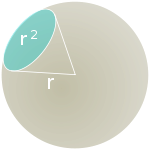 |There were a couple of “360” cameras on display. This technology has not yet made it main stream.On a personal note, I wish people would stop refering to these devices as “360” cameras; they capture images in spherical projection. Angles are a 2D measurement, and 360 degree image would be used to describe a cylindrical image.For solid angles, the correct unit is the Steradian. There are 4π Steradians in a sphere, so these devices should be more accurately called 4π cameras, and not 360 cameras (if you want to drop the units).** Or 2 Tau if you subscribe to that mindset!|
|There were a couple of “360” cameras on display. This technology has not yet made it main stream.On a personal note, I wish people would stop refering to these devices as “360” cameras; they capture images in spherical projection. Angles are a 2D measurement, and 360 degree image would be used to describe a cylindrical image.For solid angles, the correct unit is the Steradian. There are 4π Steradians in a sphere, so these devices should be more accurately called 4π cameras, and not 360 cameras (if you want to drop the units).** Or 2 Tau if you subscribe to that mindset!|
On a personal note, I wish people would stop refering to these devices as “360” cameras; they capture images in spherical projection. Angles are a 2D measurement, and 360 degree image would be used to describe a cylindrical image.
| |There’s a subtle difference between capturing spherical video and capturing speherical 3D video. A spherical video (grrr, yes, called a 360 video) is made from stitching together images to allow you to look anywhere from the point of view of where the image was captured. However, if you translate or move your head to different location, the projection is still the same based on the azimuth and inclination of your head. It’s passive.A 360 VR video (sometimes described as 360 3D), has depth and appreciates objects. The rendering is active and changes what you see (both the geometry and oclusions) based on the position and angle of your head. Each frame is rendered based on the geometry.|
|There’s a subtle difference between capturing spherical video and capturing speherical 3D video. A spherical video (grrr, yes, called a 360 video) is made from stitching together images to allow you to look anywhere from the point of view of where the image was captured. However, if you translate or move your head to different location, the projection is still the same based on the azimuth and inclination of your head. It’s passive.A 360 VR video (sometimes described as 360 3D), has depth and appreciates objects. The rendering is active and changes what you see (both the geometry and oclusions) based on the position and angle of your head. Each frame is rendered based on the geometry.|
A 360 VR video (sometimes described as 360 3D), has depth and appreciates objects. The rendering is active and changes what you see (both the geometry and oclusions) based on the position and angle of your head. Each frame is rendered based on the geometry.
Gaming laptop
Want the ultimate gaming laptop? How about this prototype creation from Razer? It features two fold out screens for when you want a portable way to have a multi-screen gaming experience. The result is three 17” screens with a 12K resolution.
I guess it doesn’t have to be used exclusively by gamers. I know plenty of developers and engineers who love to code with multi-monitor setups.

(Just don’t try getting this out on your next plane trip and attempt to do work on it using the tray table …)
3D Printing
3D printing is pretty mature technology and there were a variety of sizes of printers on display. A multiheaded device was printing things the size of a table, and one was printing with two kinds of material, one of which was water soluble to enable complex free moving components to be printed rigid, and then dunked in water to free the parts. I saw a full size bike frame that was printed and some pretty impressive full colour models. The shoes are not printed shoes that can worn; they are used as full size prototypes to gauge customer opinions and feedback to see if it is worthwhile to manufacture.
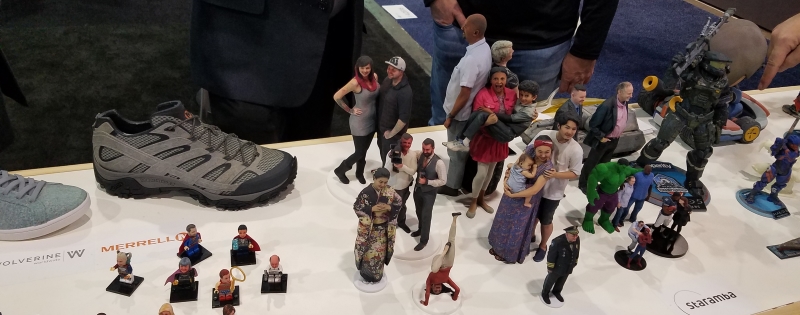
This device prints fancy nails.
Innovation Hall
I wish I’d had more time to spend in this section. It was full of entrepreneurs, builders, makers, hackers, and inventors. Some of their ideas were crazy and way out there, but all had passion an enthusiasm. Here’s a smattering:
| |
| |
|These folks claimed to have the World’s fastest varifocal lens. It’s a liquid lens with no moving parts that use pressure waves of sound to adjust the refractive index of the fluid. They claim sub-microsecond focus speeds are possible.|Here’s the World’s smallest Astronomy camera.|
|
|These folks claimed to have the World’s fastest varifocal lens. It’s a liquid lens with no moving parts that use pressure waves of sound to adjust the refractive index of the fluid. They claim sub-microsecond focus speeds are possible.|Here’s the World’s smallest Astronomy camera.|
Here’s the World’s smallest Astronomy camera.
|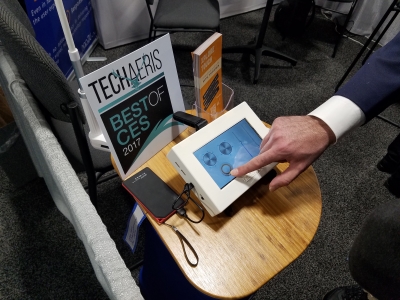 |
|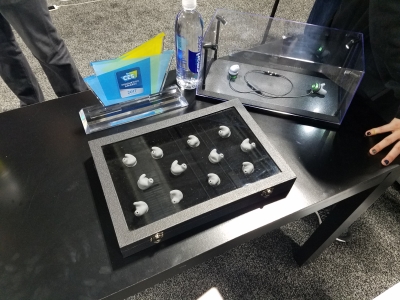 |
|This touch screen had a haptic feedback that gave indication when some events had occured. It could be configured to give feedback after certain action such as moving buttons. It worked by moving the entire display, so could not differentiate or provide multi-touch.|This award winning product is a self-fitting earpiece. First insert a gel-like blank into your ear, then a current is passed through the material changing it’s structure; a one-way process that locks the shape to that of your ear cannal. |
|
|This touch screen had a haptic feedback that gave indication when some events had occured. It could be configured to give feedback after certain action such as moving buttons. It worked by moving the entire display, so could not differentiate or provide multi-touch.|This award winning product is a self-fitting earpiece. First insert a gel-like blank into your ear, then a current is passed through the material changing it’s structure; a one-way process that locks the shape to that of your ear cannal. |
This award winning product is a self-fitting earpiece. First insert a gel-like blank into your ear, then a current is passed through the material changing it’s structure; a one-way process that locks the shape to that of your ear cannal.
| ||
|Everytime I experience one of these devices it seems like magic. This is a phased array of small speakers producing a very focussed beam of sound. When standing directly infront of it you hear the sound clearly. Even just a few degrees off angle and you hear nothing. Very cool.||
||
|Everytime I experience one of these devices it seems like magic. This is a phased array of small speakers producing a very focussed beam of sound. When standing directly infront of it you hear the sound clearly. Even just a few degrees off angle and you hear nothing. Very cool.||
Medical Devices
| |Many people close to me suffer from Parkinson’s Disease. This incredibly useful product uses active stablization to help keep a spoon steady despite the shaking of the users hand. It’s a similar type of technology that is used to stabilize web cams.Here is video of the spoon in action.|
|Many people close to me suffer from Parkinson’s Disease. This incredibly useful product uses active stablization to help keep a spoon steady despite the shaking of the users hand. It’s a similar type of technology that is used to stabilize web cams.Here is video of the spoon in action.|
Here is video of the spoon in action.
VR and AR
|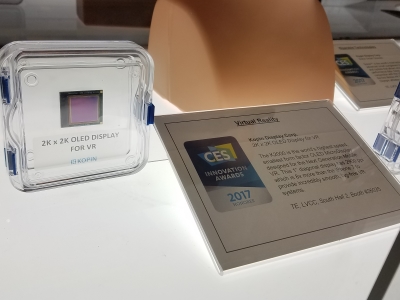 |Virtual Reality and Augmented Reality devices were on display, but you had to look out for them. They are cool, but not common Consumer Electronics at the current time.One of the show award winners was this cute 2k x 2k OLED display, with just a 1” diameter. This puts the density of pixels 2,900 per linear inch (or about 8x that of the retina type display on an iPhone).Devices like this will proliferate AR glasses.|
|Virtual Reality and Augmented Reality devices were on display, but you had to look out for them. They are cool, but not common Consumer Electronics at the current time.One of the show award winners was this cute 2k x 2k OLED display, with just a 1” diameter. This puts the density of pixels 2,900 per linear inch (or about 8x that of the retina type display on an iPhone).Devices like this will proliferate AR glasses.|
One of the show award winners was this cute 2k x 2k OLED display, with just a 1” diameter. This puts the density of pixels 2,900 per linear inch (or about 8x that of the retina type display on an iPhone).
5G
There was buzz at the show about the promise of the next geneation (5G) of mobile standards.
Intel and Qualcomm were both claiming low latency speeds at 5 Gigabits/second (10-20x that of current generation 4G LTE). This sounds pretty awesome and, if successfully rolled out, will be very damaging to the cable providers. There are still many technical challenges ahead for this (and a current lack of standards). Transmissions at the proposed wavelengths can’t penetrate very well so will need a very high density of base stations. Economically this will only make sense in dense urban environments.
All this aside, I can’t wait for a protocol with this bandwidth. There are great applications for more than just phones; this can be used to make true wireless virtual reality headsets, and the every increasing number of autonomous vehicles and drones will all benefit from fat low-latency pipes.
Trials will start later this year.
Smart Home
I didn’t get chance to see everything at the show, so I skipped past the Smart Home sections. Yes, it is now possible to replace pretty much every switch, outlet, bulb, thermostat, and door in any house with a smart and connected device.
This has great benefits for convience and potential energy savings, but the reality is that the hardware component is just part of the solution. Connecting all these devices together with common protocols that allow them to converse for a commmon goal, and then programming them is the bigger challenge. Decades ago, this is how Microsoft made it big by realizing that software is distinct from hardware; a collection of silicon is useless without an operating systems and applications.
Similarly, a smart home is not smart just because it has connected switches. It’s smart because it runs a symphony of rules. This is the harder part, and the average person is not going to either have the skill, time, or expertise to write and debug these rules.
Go back 20 years, and 9 homes out of 10 had a VCR that flashed 12:00 because the owners did not want, or could not, or did not care about, setting it up. Are these people going to want to write scripts to coordinate the syncronisation of hundreds of devices to turn on/off lights and services based on other triggers and events?
The realistic answer is “no”, so the smart home of the future is going to have to have a brain that is neural and learning in nature and will program itself and adapt smartly based on the patterns of its occupants.
We’re still a few years from this.
Silly Things
| |
| |
|Men, are you worried about exposing your sensitive reproductive organs to too much electromagnetic radiation? In that case you’ll feel much more comfortable with your family jewels safely screened inside a Faraday cage. For $47 you can purchase a pair of Spartan underwear woven with silver thread in the fabric.|No tailgate party is complete without a huge TV. The problem for how to securely mount a large flat panel display to your pickup truck has been solved with this device. It fits neatly in the tow hitch, and provides adjustments for optimal viewing angles.|
|
|Men, are you worried about exposing your sensitive reproductive organs to too much electromagnetic radiation? In that case you’ll feel much more comfortable with your family jewels safely screened inside a Faraday cage. For $47 you can purchase a pair of Spartan underwear woven with silver thread in the fabric.|No tailgate party is complete without a huge TV. The problem for how to securely mount a large flat panel display to your pickup truck has been solved with this device. It fits neatly in the tow hitch, and provides adjustments for optimal viewing angles.|
No tailgate party is complete without a huge TV. The problem for how to securely mount a large flat panel display to your pickup truck has been solved with this device. It fits neatly in the tow hitch, and provides adjustments for optimal viewing angles.
Remember those snap bracelets that were the rage a few years ago? (maybe they still are). How about this?, a snap bracelet phone. Pull it off to talk, then snap it back around your wrist when you are finished and it turns into a stylish accessory.
| |
| |
|“Share everything, always” No!, and as there are many that are concerned about privacy and security this is a very poorly selected set of words to describe your cloud services. Shame on your marketing team. “Share all that you permit” would be a much better phrase IMHO.|I don’t understand this. The human ear is sensitive and we’re constantly reading about the damage the youth of today are doing to their ears with excessive volume from ear pieces. And yet here is a company using power as a selling feature!|
|
|“Share everything, always” No!, and as there are many that are concerned about privacy and security this is a very poorly selected set of words to describe your cloud services. Shame on your marketing team. “Share all that you permit” would be a much better phrase IMHO.|I don’t understand this. The human ear is sensitive and we’re constantly reading about the damage the youth of today are doing to their ears with excessive volume from ear pieces. And yet here is a company using power as a selling feature!|
I don’t understand this. The human ear is sensitive and we’re constantly reading about the damage the youth of today are doing to their ears with excessive volume from ear pieces. And yet here is a company using power as a selling feature!
| |
| |
|Yes, this is a smart umbrella. No, however, it’s not an umbrella that automatically erects when it detects rain (that would be a little crazy and embarrassing). It does, however, sport a chip in the handle that detects when it is deployed, and measures the intensity of rain it is shielding. The goal is that it then broadcasts this information out into the cloud (see what I did there?) building a dust network of real time weather information with data combined from all (dozens?) of other folks who purchased one of these.|Here’s a robot that can dispense M remotely.|
|
|Yes, this is a smart umbrella. No, however, it’s not an umbrella that automatically erects when it detects rain (that would be a little crazy and embarrassing). It does, however, sport a chip in the handle that detects when it is deployed, and measures the intensity of rain it is shielding. The goal is that it then broadcasts this information out into the cloud (see what I did there?) building a dust network of real time weather information with data combined from all (dozens?) of other folks who purchased one of these.|Here’s a robot that can dispense M remotely.|
Here’s a robot that can dispense M remotely.
| |
| |
|Hydration management? Please! Here is a water bottle that reminds you when to drink. It’s good to know we don’t have to worry about society dying out due to people being too distracted to respond to their thirst reflex. I’m sorry, why does anyone need this product?|Ever worried that your USB charger is too thick, and you wished you had a thinner one? Worry no more. Here is the World’s thinnest USB charger.|
|
|Hydration management? Please! Here is a water bottle that reminds you when to drink. It’s good to know we don’t have to worry about society dying out due to people being too distracted to respond to their thirst reflex. I’m sorry, why does anyone need this product?|Ever worried that your USB charger is too thick, and you wished you had a thinner one? Worry no more. Here is the World’s thinnest USB charger.|
Ever worried that your USB charger is too thick, and you wished you had a thinner one? Worry no more. Here is the World’s thinnest USB charger.
| |
| |
|Yes, this is exactly what it looks like. It’s a roomba that roams over the grass identifying and picking up dog poop.(I pity the person who has to empty it every couple of days when it gets full).There was no comment from the inventors if it would produce a heatmap of where your pets most like to leave presents, or if the collector could be enhanced to check the health of the pooper.|You can use this smart brush and it will tell you something useful about your hair (probably). Even if I wasn’t slowly going bald, I don’t think I’m the target demographic for this product. It bet it will probably be able to generate a report about how often, and for how long, a user brushes their hair. There’s no end to the useful of this (probably). At least this looks like a device that can still be used if the battery is flat, or if your WiFi goes down, or you are subject to a IoT DoS attack. There were similar smart toothbrushes on display that recorded how long you brushed your teeth per day.|
|
|Yes, this is exactly what it looks like. It’s a roomba that roams over the grass identifying and picking up dog poop.(I pity the person who has to empty it every couple of days when it gets full).There was no comment from the inventors if it would produce a heatmap of where your pets most like to leave presents, or if the collector could be enhanced to check the health of the pooper.|You can use this smart brush and it will tell you something useful about your hair (probably). Even if I wasn’t slowly going bald, I don’t think I’m the target demographic for this product. It bet it will probably be able to generate a report about how often, and for how long, a user brushes their hair. There’s no end to the useful of this (probably). At least this looks like a device that can still be used if the battery is flat, or if your WiFi goes down, or you are subject to a IoT DoS attack. There were similar smart toothbrushes on display that recorded how long you brushed your teeth per day.|
(I pity the person who has to empty it every couple of days when it gets full).
You can use this smart brush and it will tell you something useful about your hair (probably). Even if I wasn’t slowly going bald, I don’t think I’m the target demographic for this product. It bet it will probably be able to generate a report about how often, and for how long, a user brushes their hair. There’s no end to the useful of this (probably). At least this looks like a device that can still be used if the battery is flat, or if your WiFi goes down, or you are subject to a IoT DoS attack. There were similar smart toothbrushes on display that recorded how long you brushed your teeth per day.
| |
| |
|If you have a chill, and are feeling under the weather, putting your feet in a warm bath of steaming water is reputed to do wonders for you. What if you need more? This device allows you to sit down and, erm … it gently steams you from below. (I did not try it).|This is not a portable cement mixer, it’s a motorized cat litter box. It’s proudly advertised as the last cat litter box you will ever buy.|
|
|If you have a chill, and are feeling under the weather, putting your feet in a warm bath of steaming water is reputed to do wonders for you. What if you need more? This device allows you to sit down and, erm … it gently steams you from below. (I did not try it).|This is not a portable cement mixer, it’s a motorized cat litter box. It’s proudly advertised as the last cat litter box you will ever buy.|
This is not a portable cement mixer, it’s a motorized cat litter box. It’s proudly advertised as the last cat litter box you will ever buy.
| ||
|Anyone want a smart pan? It measures the weight of the food you put in it, and it’s temperature. You can then share this information with chefs all over the World. I’m sure they will thank you.||
||
|Anyone want a smart pan? It measures the weight of the food you put in it, and it’s temperature. You can then share this information with chefs all over the World. I’m sure they will thank you.||
CES 2018
See you next year CES!
You can find a complete list of all the articles here. Click here to receive email alerts on new articles.
Click here to receive email alerts on new articles.